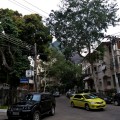ReDoing Deforestation Damage
Cécile S | June 21, 2012.
Urgent action is needed to protect forests at Rio+20, but the negotiations are yet to produce a strong outcome.
Every year an forest area the size of Nicaragua is lost to produce fuel, palm oil and soy. At the completion of reading this article, the area of a soccer field will have been cut down, and not replaced.
But the problem extends beyond the loss of forest cover.
“Forests absorb about one-fifth of the carbon released through greenhouse gas emissions, and we keep destroying them,” said Yolanda Kakabadse, president of the World Wildlife Fund (WWF).
“Our forests must be maintained and we must commit to zero net deforestation by 2020, so that forests can provide for future generations,” according to André Giacini de Freitas, executive director of the Forest Stewardship Council.
Kakabadse admits “zero deforestation by 2020 is ambitious,” but is confident that it is feasible. “We have to work for it through governments, production sector and civil society,” he urges.
A key challenge is increasing populations and their need for food, which puts a strain on forests.
“Deforestation is a profitable activity on which the poorest rely, so incentives are very complicated to implement,“ explains Lu Zhi, the director of the Center for Nature and Society.
One of the proposals is to financially compensate local communities for not cutting down their trees. This is the core idea of the mechanism of Reducing Emissions from Deforestation and Degradation (REDD+), launched seven years ago.
“There are a lot of practical challenges, but there are workable, technical solutions to these, so the main problems are really the political ones,” says Arild Angelsen, an environmental economist with CIFOR.
“You cannot address climate change without including REDD+,” added Arild Angelsen, an environmental economist and professor.
“REDD+ as an idea is a success story,” Angelsen asserts confidently. “It was something genuinely new … it was based on payments for performance or results.”
“We compare it to ‘sustainable development’. Both ideas have been an inspiration for policy makers and practitioners.”
As REDD+ has moved from an idea into the real world, difficulties have sprouted. These challenges are both logistical and political. They range from monitoring and accounting tools to deciding who should benefit financially.
“REDD+ design and implementation is extremely challenging,” Angelsen admits. “The devil is in the detail – when you start to work out the specifics of REDD+ then there is more conflict.”
An emerging problem for REDD+ is how to develop reference levels to provide a benchmark for measuring the impact. There is also a need for a standardised mechanism to measure how much carbon has been ‘saved’. This is currently difficult with a lack of data, uncertainty around projected deforestation rates and political bias.
REDD+ is not without existing critics including Bertha Becker, Professor at the Federal University of Rio de Janeiro. “Improvement of life conditions for forest populations will not come through Payments of Environmental Services (PES), such as REDD+, because it consists in a market that creates profits but will not benefit the local communities.”
The state of Chiapas in Mexico is an example of that as the sale of carbon credits results in the displacement of people. Residents have lived generationally in the heart of old forests and would culturally struggle to accept a monetary compensation for forests.
“Despite of the challenges, we have to make REDD+ work, it’s the only option we have,” said Edward Davey, from the Prince’s Rainforest Project. If we find a way of defining national REDD programs in a consensual way, including all stakeholder in the process, REDD would be the saver of our forests.”
Of the 238 paragraphs to be adopted at this conference, only four pertain to forests and the one focused on REDD+ is unlikely to be adopted.
By Cécile Schneider, photo by Sam Bowstead.












comment